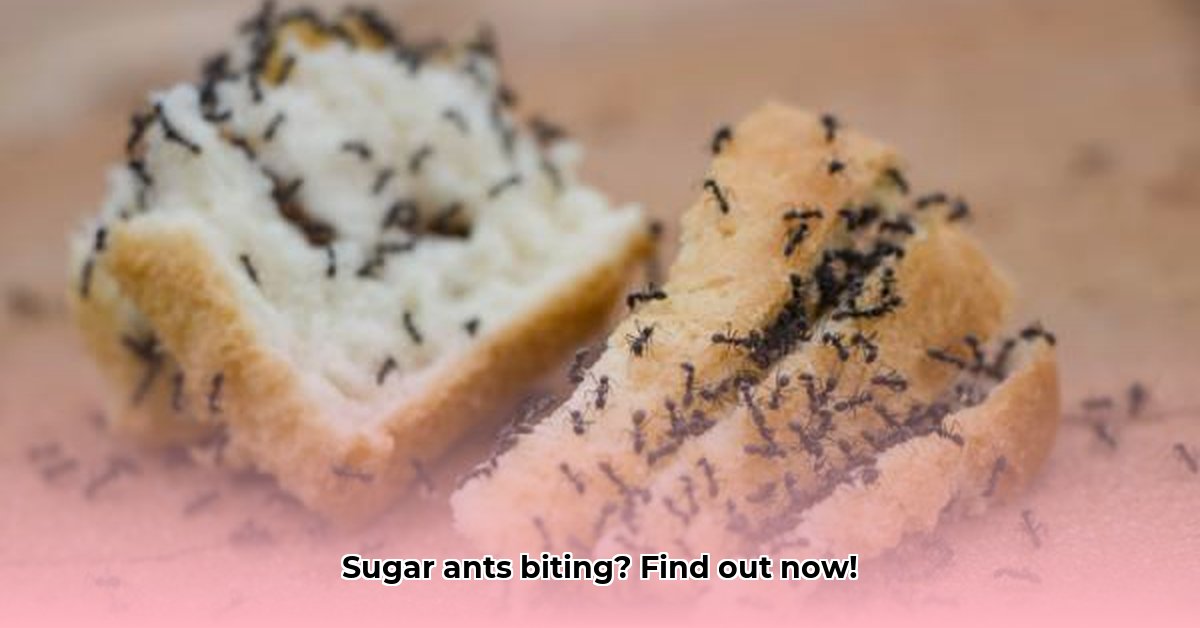So, you’ve got sugar ants crawling around your kitchen. Annoying, right? But do they actually bite? That’s what we’re here to figure out. This guide will walk you through everything you need to know about these tiny invaders, from identifying them to getting rid of them for good. We’ll cover quick fixes for a current infestation and give you tips to prevent future problems. Whether you’re a seasoned DIYer or just want a pest-free home, this guide will help you conquer those sugar ants!
Do Sugar Ants Bite? Understanding the Facts and Finding Relief
Let’s talk sugar ants – those tiny invaders often found raiding your kitchen counters. The big question is: do they bite? The short answer is yes, they can bite, but it’s generally not a major concern. Sugar ant bites are typically mild and pose no serious health risks. However, understanding their behavior and taking preventive measures can help keep them at bay. Let’s explore everything you need to know about sugar ants and how to keep your home pest-free.
Identifying Sugar Ants: Not All Ants Are Created Equal
The term “sugar ant” isn’t a specific species, but a catch-all for various small ant species attracted to sweet substances. In the United States, this often refers to odorous house ants (Tapinoma sessile), known for their preference for sugary foods and the distinct coconut-like odor they emit when crushed. Other common “sugar ants” include pavement ants, Argentine ants, and pharaoh ants. Correct identification is crucial for effective control.
- Odorous House Ants: Dark brown or black, small (1/16 to 1/8 inch), and emit a rotten coconut smell when crushed.
- Pavement Ants: Dark brown to black, slightly larger than odorous house ants, and often nest under sidewalks and driveways.
- Argentine Ants: Light brown, small, and known for forming large colonies.
- Pharaoh Ants: Yellowish-brown, very small, and can establish colonies in hard-to-reach places like wall voids.
Sugar Ant Bites: What to Expect
Sugar ants aren’t aggressive and typically only bite if they feel threatened or disturbed. Their bites are generally harmless to humans and pets. The bite itself is often described as a mild pinch or tickle, and most people experience no lasting symptoms. However, on rare occasions, a bite can cause slight redness, itching, or minor swelling.
Symptoms of a Sugar Ant Bite:
- Mild, temporary pain or discomfort
- Small, red mark on the skin
- Slight itching
- Localized swelling (rare)
First Aid for Sugar Ant Bites
If you’re bitten by a sugar ant, follow these simple steps:
- Wash the Area: Gently wash the bite area with soap and water to prevent infection.
- Apply a Cold Compress: Apply a cold compress or ice pack to reduce any minor swelling or discomfort.
- Antihistamine Cream: For itching, apply an over-the-counter antihistamine cream.
When to Seek Medical Attention:
- Symptoms of an allergic reaction (difficulty breathing, swelling of the face or throat, hives)
- Signs of infection (increased pain, redness, swelling, pus)
Preventing Sugar Ant Invasions: A Comprehensive Guide
The best way to deal with sugar ants is to prevent them from entering your home in the first place. Here’s a comprehensive prevention strategy:
1. Eliminate Food Sources:
- Cleanliness: Regularly clean kitchen surfaces, sweep floors, and wipe up spills immediately.
- Proper Food Storage: Store food, especially sugary items, in airtight containers.
- Trash Management: Empty trash cans regularly and keep them clean.
2. Seal Entry Points:
- Caulk Cracks and Gaps: Seal any cracks or openings in walls, windows, and doors with caulk or sealant.
- Weather Stripping: Install weather stripping around doors and windows to prevent ants from entering.
- Check Utility Lines: Seal any openings around pipes and utility lines.
3. Natural Deterrents:
- Vinegar: Spray a mixture of equal parts white vinegar and water around areas where you see ants.
- Peppermint Oil: Place cotton balls soaked in peppermint oil near entry points.
- Cinnamon: Sprinkle cinnamon around areas where ants are likely to enter.
4. Ant Baits:
- Strategic Placement: Place ant baits in areas where you see ants, such as under sinks, near appliances, and along baseboards.
- Type of Bait: Choose a bait that is specifically designed for sugar ants.
- Patience: It may take a few days or weeks for the bait to eliminate the colony.
5. Professional Pest Control:
- Severe Infestations: If you have a severe infestation, it’s best to call a professional pest control service.
- Identification: A professional can correctly identify the species of ant and recommend the most effective treatment.
- Long-Term Solutions: Professionals can provide long-term solutions to prevent future infestations.
Comparing Control Methods: Pros and Cons
| Method | Pros | Cons |
|---|---|---|
| Cleaning and Sanitation | Environmentally friendly, safe, cost-effective, prevents future infestations | Requires consistent effort |
| Sealing Entry Points | Environmentally friendly, cost-effective, long-term prevention | Requires thorough inspection and sealing |
| Natural Deterrents | Safe for pets and children, environmentally friendly | May not be as effective for large infestations, requires frequent reapplication |
| Ant Baits | Targeted, effective for eliminating colonies, can be used indoors | Requires patience, may attract more ants initially, potential hazards if not used properly |
| Professional Pest Control | Most effective for severe infestations, provides long-term solutions, expert identification and treatment | More expensive, may involve the use of chemicals, requires scheduling and coordination |
Key Takeaways
- Sugar ants are attracted to sweet substances and moisture.
- Their bites are generally harmless but can cause allergic reactions in some individuals.
- Preventing infestations involves eliminating food sources, sealing entry points, and using natural deterrents or ant baits.
- Professional pest control is recommended for severe infestations.
By understanding sugar ant behavior and implementing these preventive measures, you can keep your home ant-free and minimize the risk of bites.
Identifying and Eliminating Sugar Ant Infestations in Kitchens and Bathrooms
Do you dread the sight of sugar ants invading your kitchen or bathroom? These tiny pests can quickly become a nuisance, contaminating food and creating unsanitary conditions. Understanding what attracts them and how to effectively eliminate them is key to maintaining a pest-free home.
Understanding Why Sugar Ants Invade Kitchens and Bathrooms
Kitchens and bathrooms are prime targets for sugar ants due to the abundance of food sources and moisture. Spilled sugar, crumbs, sticky residues, and leaky pipes attract these pests in droves. In the kitchen, they’re drawn to:
- Spilled sugar, honey, syrup, and other sweets
- Crumbs on countertops, floors, and in cabinets
- Dirty dishes and food residue in sinks
-
Pet food
In the bathroom, they seek out: -
Moisture from leaky faucets, showers, and toilets
- Soap residue and toothpaste
- Humid environments
Preventing Sugar Ant Infestations: A Step-by-Step Guide
Preventing sugar ant infestations requires a multi-pronged approach that targets their food sources, entry points, and nesting sites:
1. Eliminate Food and Water Sources:
- Cleanliness: Regularly clean kitchen and bathroom surfaces, sweep floors, and wipe up spills immediately.
- Proper Food Storage: Store food, especially sugary items, in airtight containers.
- Fix Leaks: Repair any leaky faucets, pipes, or toilets to eliminate moisture sources.
- Empty Trash Regularly: Empty trash cans regularly and keep them clean.
2. Seal Entry Points:
- Caulk Cracks and Gaps: Seal any cracks or openings in walls, windows, doors, and around pipes with caulk or sealant.
- Weather Stripping: Install weather stripping around doors and windows to prevent ants from entering.
- Screen Vents and Drains: Install screens over vents and drains to prevent ants from entering through these openings.
3. Natural Deterrents:
- Vinegar: Wipe down surfaces with a mixture of equal parts white vinegar and water.
- Peppermint Oil: Place cotton balls soaked in peppermint oil near entry points.
- Cinnamon: Sprinkle cinnamon around areas where ants are likely to enter.
4. Ant Baits:
- Strategic Placement: Place ant baits in areas where you see ants, such as under sinks, near appliances, and along baseboards.
- Type of Bait: Choose a bait that is specifically designed for sugar ants.
- Patience: It may take a few days or weeks for the bait to eliminate the colony.
- Monitor and Replace: Regularly monitor the bait stations and replace them as needed.
- Gluten Free Meal Prep Ideas for Delicious, Hassle-Free Eating - November 28, 2025
- Gluten Free Meal Prep for Stress-Free and Healthy Eating - November 27, 2025
- Quick And Easy Chicken Thigh Meal Prep For Weight Loss - November 26, 2025










